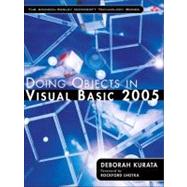
What is included with this book?
Deborah Kurata is cofounder of InStep Technologies Inc. (http://www. insteptech.com), a professional consulting firm that focuses on turning your business vision into reality using Microsoft .NET technologies. InStep provides premier software design, development, and consulting services to the most successful companies in Silicon Valley, the San Francisco Bay area, and other locations nationwide. You can reach InStep at 925-730-1000 or at info@insteptech.com.
Deborah has more than 15 years of experience in architecting, designing, and developing successful applications. She has authored several books, including the Doing Objects in Visual Basic series (Sams), Best Kept Secrets in .NET (Apress), and Doing Web Development: Client-Side Techniques (Apress). She also writes for MSDN and CoDe magazine (http://www.code-magazine.com/).
Deborah speaks at .NET user groups all over the country as a member of the INETA Speaker’s Bureau (http://www.ineta.org/) and at conferences such as VSLive, DevDays, and TechEd. For her work in support of software development and software developers, she has been recognized with the Microsoft Most Valuable Professional (MVP) award. After a hard day of coding and taking care of her family, Deborah enjoys blowing stuff up (on the XBox, of course).
Deborah holds degrees in physics and mathematics from the University of Wisconsin—Eau Claire and an MBA from the College of William and Mary.
| Foreword | p. xvii |
| Preface | p. xix |
| Introduction to OO in .NET | p. 1 |
| Designing Software | p. 39 |
| Building Projects | p. 99 |
| Building the User Interface Layer | p. 151 |
| Building the Business Logic Layer | p. 251 |
| Class Tools and Techniques | p. 307 |
| Binding the User Interface to the Business Objects | p. 357 |
| Building the Data Access Layer | p. 439 |
| Index | p. 503 |
| Table of Contents provided by Publisher. All Rights Reserved. |
The New copy of this book will include any supplemental materials advertised. Please check the title of the book to determine if it should include any access cards, study guides, lab manuals, CDs, etc.
The Used, Rental and eBook copies of this book are not guaranteed to include any supplemental materials. Typically, only the book itself is included. This is true even if the title states it includes any access cards, study guides, lab manuals, CDs, etc.